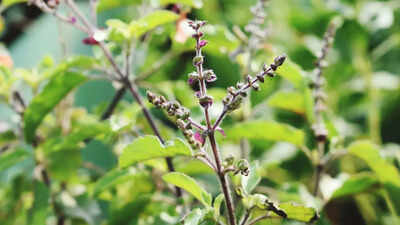- News
- lifestyle
- home-garden
- How to prevent Tulsi plant from dying in winter
Trending
How to prevent Tulsi plant from dying in winter
Safeguarding the revered Tulsi plant during winter requires mindful care. Shielding it from harsh elements with covers, ensuring ample sunlight, and moderate watering with lukewarm water are crucial. Proper pot size, regular pruning, fresh soil, and controlled harvesting contribute to its health. Natural fertilizers and evening covering provide added protection, ensuring this sacred plant thrives throughout the colder months.
The Tulsi plant, also known as Holy Basil, holds a sacred status in Hindu culture and is often found in many households. However, during the winter months, this revered plant requires extra attention to thrive. Cold winds and fog can cause the Tulsi to wilt, to ensure your Tulsi plant remains healthy throughout winter, here are some effective strategies.

Creating a barrier: Shield against the chill
To keep your Tulsi plant safe from harsh winter conditions, it’s vital to shield it from cold winds and frost. You can do this by placing a protective barrier around the plant, such as a plastic cover or cloth during the night. This simple action helps prevent wilting and maintains the plant's overall health by blocking out harsh external elements.
Tulsi plants cannot withstand frost and thrive best with adequate sunlight. Place your plant in a location where it can receive 4-6 hours of direct sunlight daily. A sheltered spot under a net can provide protection from harsh winter elements while still allowing sunlight to nourish the plant.
Water wisely: Moderate watering techniques
During winter, the watering requirements for your Tulsi change significantly. It’s crucial to adopt a moderate watering approach to avoid both overwatering and drying out the soil. Check the top 2 inches of soil; if it's dry, it's time to water. This careful monitoring helps prevent root rot caused by excess moisture while ensuring the leaves remain healthy.
Warm temperature: Use lukewarm water
When watering your Tulsi plant in winter, opt for lukewarm water instead of cold. Cold water can contribute to dry leaves, so warming it up helps maintain proper moisture levels. For added benefits, consider mixing a small amount of raw milk with the water before applying it to your plant.
Pot size matters: Choosing the right container
The size of your pot significantly influences how much water your Tulsi needs. Ensure that you adjust your watering routine based on the pot size to provide adequate hydration without overwhelming the roots. A well-sized pot allows for better drainage and air circulation, which are essential for a healthy plant.
Trim for growth: Practice regular pruning
Regular pruning is essential for maintaining a healthy Tulsi plant. By removing dead or infected parts of the plant, you promote better air circulation and allow sunlight to reach all areas of the plant. This practice not only helps in revitalizing your Tulsi but also encourages new growth during the colder months.
Fresh start: Adding new soil
To keep your Tulsi thriving, regularly mix in fresh soil. Old soil may lack sufficient oxygen and nutrients necessary for growth. By adding fresh soil, you ensure that the roots receive adequate oxygen and nutrients, supporting overall health and vitality in winter.
Harvest wisely: Avoid over-picking leaves
While many people use Tulsi leaves for cooking or medicinal purposes, over-harvesting can harm the plant's health. Plucking too many leaves at once can lead to stress and potential rot within the plant. It’s best to be mindful of how many leaves you take to ensure your Tulsi remains healthy.
Nourish regularly: Proper fertilization techniques
To support your Tulsi’s revival during winter, fertilize it every two weeks with natural options like cow dung manure or dried tea leaves. This regular feeding provides essential nutrients that help sustain growth and vitality throughout the colder months.
Evening cover: Extra protection at night
For additional protection against night-time chills, cover your Tulsi with plastic or cloth in the evenings. This simple act can help guard against cold winds while allowing sunlight exposure during the day when temperatures rise.

Following these steps can significantly enhance your Tulsi plant's chances of surviving and thriving through winter. By providing proper care and attention, you can ensure that this sacred plant continues to flourish in your home.
End of Article
FOLLOW US ON SOCIAL MEDIA
Visual Stories
Tired of too many ads?go ad free now











